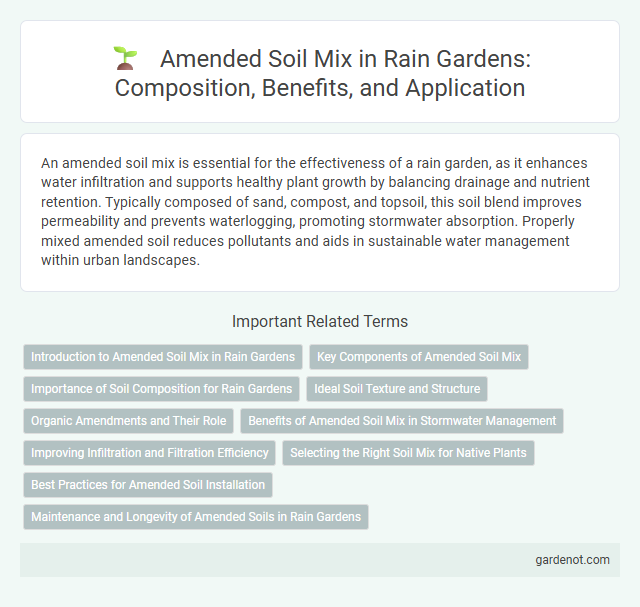An amended soil mix is essential for the effectiveness of a rain garden, as it enhances water infiltration and supports healthy plant growth by balancing drainage and nutrient retention. Typically composed of sand, compost, and topsoil, this soil blend improves permeability and prevents waterlogging, promoting stormwater absorption. Properly mixed amended soil reduces pollutants and aids in sustainable water management within urban landscapes.
Introduction to Amended Soil Mix in Rain Gardens
Amended soil mix in rain gardens enhances water infiltration and supports healthy plant growth by combining native soil with organic matter like compost. This blend improves soil structure, increases nutrient availability, and promotes moisture retention critical for efficient stormwater management. Properly formulated amended soil ensures rain gardens effectively filter pollutants and reduce surface runoff.
Key Components of Amended Soil Mix
Amended soil mix for rain gardens typically consists of a well-balanced blend of sand, compost, and native soil to enhance drainage and nutrient retention. Sand improves permeability, allowing rainwater to infiltrate quickly, while compost boosts organic matter and microbial activity essential for plant health. Incorporating native soil ensures compatibility with local ecosystem conditions and supports sustainable vegetation growth.
Importance of Soil Composition for Rain Gardens
Soil composition is crucial for rain gardens as it directly impacts water infiltration and plant health. An amended soil mix, typically combining sand, compost, and native soil, enhances permeability while providing essential nutrients. Properly balanced soil prevents runoff, reduces erosion, and supports sustainable stormwater management in urban environments.
Ideal Soil Texture and Structure
Amended soil mix for rain gardens should have a balanced loamy texture combining sand, silt, and organic matter to optimize drainage and water retention. Ideal soil structure features well-aggregated particles that enhance permeability while preventing compaction, promoting healthy root growth and microbial activity. Incorporating compost and coarse sand improves nutrient availability and infiltration rates essential for effective stormwater management.
Organic Amendments and Their Role
Amended soil mix in rain gardens is enriched with organic amendments such as compost, mulch, and aged manure to enhance soil structure, nutrient content, and water retention. These organic materials improve microbial activity and promote healthy root development, which is essential for effective pollutant filtration and stormwater absorption. Incorporating a balanced blend of organic amendments supports sustainable plant growth and optimizes the rain garden's ability to manage runoff efficiently.
Benefits of Amended Soil Mix in Stormwater Management
Amended soil mix enhances stormwater management by improving infiltration rates and increasing water retention capacity, reducing surface runoff and minimizing flood risks. The organic matter and structured composition promote soil aeration and microbial activity, which facilitate pollutant breakdown and nutrient uptake. These benefits support healthier plant growth and contribute to the overall effectiveness of rain gardens in managing stormwater sustainably.
Improving Infiltration and Filtration Efficiency
Amended soil mix in rain gardens enhances infiltration by increasing soil porosity and water-holding capacity, facilitating faster absorption of stormwater runoff. Incorporating organic matter and sand improves filtration efficiency by trapping pollutants and sediments, preventing contaminants from reaching groundwater. Optimized soil amendments promote microbial activity, which further aids in breaking down pollutants, thus maintaining healthier urban water cycles.
Selecting the Right Soil Mix for Native Plants
Amended soil mix for rain gardens should balance drainage and water retention to support native plants' root health and growth. Incorporating organic matter such as compost improves nutrient availability and soil structure, while sand or gravel enhances permeability to prevent waterlogging. Selecting a soil mix tailored to the native species' requirements ensures optimal plant establishment and long-term sustainability in rain garden ecosystems.
Best Practices for Amended Soil Installation
Use a well-draining amended soil mix combining native soil, compost, and sand or fine gravel to enhance permeability and nutrient retention in rain gardens. Ensure thorough mixing to create a uniform medium that supports diverse plant roots and promotes efficient water infiltration. Avoid compacting the soil during installation to maintain porosity and prevent surface runoff.
Maintenance and Longevity of Amended Soils in Rain Gardens
Maintaining an amended soil mix in rain gardens requires regular monitoring of soil texture and nutrient levels to ensure optimal water infiltration and plant health. Incorporating organic matter such as compost enhances microbial activity, which improves soil structure and supports long-term soil fertility. Periodic replenishment of amendments prevents soil compaction and nutrient depletion, sustaining the garden's effectiveness in stormwater management over time.
Amended soil mix Infographic

 gardenot.com
gardenot.com